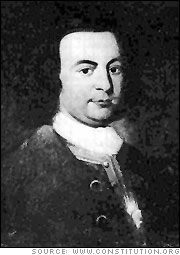George Mason

Biography of the American political leader
 In 1776, George Mason wrote the Virginia Bill of Rights, which served as the model for the U.S Bill of Rights. |
George Mason, 1725–92, American political leader, b. Fairfax co., Va. He was one of the most affluent of the colonial Virginia planters. In his triple capacity as trustee of Alexandria (1754–79), justice of the Fairfax county court, and vestryman of Truro parish, Mason exercised great influence in local politics. In 1752 he became a member of the Ohio Company (serving as treasurer until 1773), and in 1759 he was elected to the Virginia house of burgesses.
An early opponent of British colonial policy, he drafted the nonimportation resolutions adopted (1769) by the burgesses against the British and also wrote (1774) the Fairfax Resolves, which restated the constitutional position of the colonies in relation to the crown. Mason served on the Virginia committee of safety, and as a member of the Virginia constitutional convention of 1776 he drafted the well-known declaration of rights, which was extensively copied by other American states, and which was drawn on by Thomas Jefferson in the first part of the Declaration of Independence.
He was a member of the Constitutional Convention at Philadelphia (1787) and took an active part in drafting the Constitution; however, he objected to provisions for the centralization of power, the compromise between the New England and the Southern states on the tariff and slave trade issues, and the failure to include a bill of rights. Mason refused to sign the Constitution, and with Patrick Henry he led the fight in Virginia against its ratification; the bill of rights he advocated was the basis for some of the first 10 amendments (the Bill of Rights) to the Constitution.
The Columbia Electronic Encyclopedia, 6th ed. Copyright © 2005, Columbia University Press. All rights reserved.







